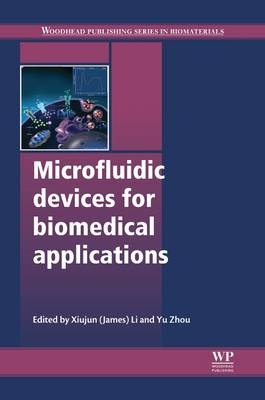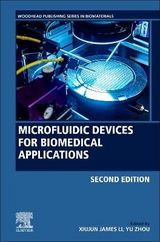
Microfluidic Devices for Biomedical Applications
Woodhead Publishing Ltd (Verlag)
978-0-85709-697-5 (ISBN)
- Titel erscheint in neuer Auflage
- Artikel merken
Microfluidics or lab-on-a-chip (LOC) is an important technology suitable for numerous applications from drug delivery to tissue engineering. Microfluidic devices for biomedical applications discusses the fundamentals of microfluidics and explores in detail a wide range of medical applications.The first part of the book reviews the fundamentals of microfluidic technologies for biomedical applications with chapters focussing on the materials and methods for microfabrication, microfluidic actuation mechanisms and digital microfluidic technologies. Chapters in part two examine applications in drug discovery and controlled-delivery including micro needles. Part three considers applications of microfluidic devices in cellular analysis and manipulation, tissue engineering and their role in developing tissue scaffolds and stem cell engineering. The final part of the book covers the applications of microfluidic devices in diagnostic sensing, including genetic analysis, low-cost bioassays, viral detection, and radio chemical synthesis.Microfluidic devices for biomedical applications is an essential reference for medical device manufacturers, scientists and researchers concerned with microfluidics in the field of biomedical applications and life-science industries.
XiuJun (James) Li, Ph.D., is an Associate Professor with early tenure in the Department of Chemistry and Biochemistry, Biomedical Engineering, and Border Biomedical Research Center at the University of Texas at El Paso (UTEP), USA. After he obtained his Ph.D. degree in microfluidic lab-on-a-chip bioanalysis from Simon Fraser University (SFU) in Canada in 2008, he pursued his postdoctoral research with Prof. Richard Mathies at University of California Berkeley and Prof. George Whitesides at Harvard University, while holding a Postdoctoral Fellowship from Natural Sciences and Engineering Research Council (NSERC) of Canada. He has gained extensive experience in bioanalysis using microfluidic systems, such as single-cell analysis, genetic analysis, low-cost diagnosis, pathogen detection, 3D cell culture, and so on. Dr. Li’s current research interest is centered on the development of innovative microfluidic lab-on-a-chip and nanotechnology for bioanalysis, biomaterial, biomedical engineering, and environmental applications, including but not limited to low-cost diagnosis, nano-biosensing, tissue engineering, and single-cell analysis. He has coauthored about 100 publications in high-impact journals (such as Adv. Drug Deliv. Rev, Appl. Catal. B-Environ, Anal. Chem., Lab Chip, Biosens. Bioelectron.) and 22 patents, including two books from Elsevier on microfluidic devices for biomedical applications. He is an Advisory Board member of Lab on a Chip and Analyst, the Founder of microBioChip Diagnostics LLC, and an editor of 6 journals including Scientific Reports from the Nature publishing group, Micromachines, etc. He is the recipient of the “Bioanalysis New Investigator Award in 2014, UT STARS Award in 2012, NSERC Postdoctoral Fellow Award in 2009, and so on. For more information, please visit http://li.utep.edu. Yu Zhou, PhD, is a Research Scientist in the Department of Research and Development at ABS Global Inc., USA. Dr Zhou received his Ph.D. degree in mechanical engineering from University of Illinois at Chicago in 2010. After graduation, he joined ABS Global, the world-leading genetics provider company as a key researcher and has been working on the development of a high-throughput microfluidic cytometry for biological cell detection and manipulation. He obtained extensive experience in design and fabrication of silicon-based microsystems and disposal plastic microfluidic chips, precision fluid delivery, and microfluidics-based single cell separation and analysis. He is a member of ASME and serves on the advisory editorial board for several technical journals including Microsystem Technologies, and Journal of Mechanical Engineering Research (Canada) since 2011.
Contributor contact details
Woodhead Publishing Series in Biomaterials
About the editors
Preface
Part I: Fundamentals of microfluidic technologies for biomedical applications
Chapter 1: Materials and methods for the microfabrication of microfluidic biomedical devices
Abstract:
1.1 Introduction
1.2 Microfabrication methods
1.3 Materials for biomedical devices
1.4 Polymers
1.5 Conclusion and future trends
1.7 Appendix: acronyms
Chapter 2: Surface coatings for microfluidic-based biomedical devices
Abstract:
2.1 Introduction
2.2 Covalent immobilization strategies: polymer devices
2.3 Covalent immobilization strategies: glass devices
2.4 Adsorption strategies
2.5 Other strategies utilizing surface treatments
2.6 Examples of applications
2.7 Conclusion and future trends
2.8 Sources of further information and advice
Chapter 3: Actuation mechanisms for microfluidic biomedical devices
Abstract:
3.1 Introduction
3.2 Electrokinetics
3.3 Acoustics
3.4 Limitations and future trends
Chapter 4: Digital microfluidics technologies for biomedical devices
Abstract:
4.1 Introduction
4.2 On-chip microdrop motion techniques
4.3 Sensing techniques
4.4 Future trends
4.5 Conclusion
Part II: Applications of microfluidic devices for drug delivery and discovery
Chapter 5: Controlled drug delivery using microfluidic devices
Abstract:
5.1 Introduction
5.2 Microreservoir-based drug delivery systems
5.3 Micro/nanofluidics-based drug delivery systems
5.4 Conclusion
5.5 Future trends
Chapter 6: Microneedles for drug delivery and monitoring
Abstract:
6.1 Introduction
6.2 Fabrication of microneedles (MNs)
6.3 MN design parameters and structure
6.4 Strategies for MN-based drug delivery
6.5 MN-mediated monitoring using skin interstitial fluid (ISF) and blood samples
6.6 Future trends
6.7 Conclusion
Chapter 7: Microfluidic devices for drug discovery and analysis
Abstract:
7.1 Introduction
7.2 Microfluidics for drug discovery
7.3 Microfluidics for drug analysis and diagnostic applications
7.4 Conclusion and future trends
7.5 Sources of further information and advice
Part III: Applications of microfluidic devices for cellular analysis and tissue engineering
Chapter 8: Microfluidic devices for cell manipulation
Abstract:
8.1 Introduction
8.2 Microenvironment on cell integrity
8.3 Microscale fluid dynamics
8.4 Manipulation technologies
8.5 Manipulation of cancer cells in microfluidic systems
8.6 Conclusion and future trends
8.7 Sources of further information and advice
Chapter 9: Microfluidic devices for single-cell trapping and automated micro-robotic injection
Abstract:
9.1 Introduction
9.2 Device design and microfabrication
9.3 Experimental results and discussion
9.4 Conclusion
9.5 Acknowledgements
Chapter 10: Microfluidic devices for developing tissue scaffolds
Abstract:
10.1 Introduction
10.2 Key issues and technical challenges for successful tissue engineering
10.3 Microfluidic device platforms
10.4 Conclusion and future trends
Chapter 11: Microfluidic devices for stem cell analysis
Abstract:
11.1 Introduction
11.2 Technologies used in stem cell analysis
11.3 Examples of microfluidic platform for stem cell analysis: stem cell culture platform – mimicking in vivo culture conditions in vitro
11.4 Examples of microfluidic platform for stem cell analysis: single stem cell analysis
11.5 Microdevices for label-free and non-invasive monitoring of stem cell differentiation
11.6 Microfluidics stem cell separation technology
11.7 Conclusion and future trends
Part IV: Applications of microfluidic devices in diagnostic sensing
Chapter 12: Development of immunoassays for protein analysis on nanobioarray chips
Abstract:
12.1 Introduction
12.2 Technologies
12.3 Immobilization chemistry
12.4 Detection methods
12.5 Applications
12.6 Conclusion and future trends
Chapter 13: Integrated microfluidic systems for genetic analysis
Abstract:
13.1 Introduction
13.2 Integrated microfluidic systems
13.3 Development of integrated microdevices
13.4 Applications of fully integrated systems in genetic analysis
13.5 Conclusion and future trends
Chapter 14: Low-cost assays in paper-based microfluidic biomedical devices
Abstract:
14.1 Introduction
14.2 Fabrication techniques for paper-based microfluidic devices
14.3 Detection and read-out technologies
14.4 Application of paper-based microfluidic devices
14.5 Conclusion and future trends
Chapter 15: Microfluidic devices for viral detection
Abstract:
15.1 Introduction
15.2 Microfluidic technologies used for viral detection
15.3 Examples of applications
15.4 Conclusion and future trends
15.5 Acknowledgements
Chapter 16: Microfluidics for monitoring and imaging pancreatic islet and β-cells for human transplant
Abstract:
16.1 Introduction
16.2 Insulin secretory pathway: how glucose sensing and metabolic coupling translates to insulin kinetics
16.3 Technologies: the emergence of microfluidics applied to islet and β-cell study
16.4 Design and fabrication of the University of Illinois at Chicago (UIC) microfluidic device
16.5 Protocol: materials
16.6 Protocol: procedures
16.7 Anticipated results
16.8 Acknowledgements
Chapter 17: Microfluidic devices for radio chemical synthesis
Abstract:
17.1 Introduction
17.2 Medical applications of microfluidic radiochemistry: positron emission tomography (PET) and single photon emission computed tomography (SPECT)
17.3 Advantages and disadvantages of microfluidic devices
17.4 Realization of promises: the superiority of microfluidic systems
17.5 Current problems for microfluidic technology
17.6 Recent developments with potential impact
17.7 Conclusion
Index
| Reihe/Serie | Woodhead Publishing Series in Biomaterials |
|---|---|
| Verlagsort | Cambridge |
| Sprache | englisch |
| Maße | 156 x 234 mm |
| Gewicht | 1170 g |
| Themenwelt | Medizin / Pharmazie ► Physiotherapie / Ergotherapie ► Orthopädie |
| Technik ► Maschinenbau | |
| Technik ► Medizintechnik | |
| ISBN-10 | 0-85709-697-4 / 0857096974 |
| ISBN-13 | 978-0-85709-697-5 / 9780857096975 |
| Zustand | Neuware |
| Haben Sie eine Frage zum Produkt? |
aus dem Bereich



